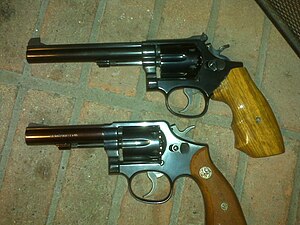
The .38 Special, also commonly known as .38 S&W Special, .38 Smith & Wesson Special, .38 Spl, .38 Spc, or 9×29mmR is a rimmed, centerfire cartridge designed by Smith & Wesson.

The Colt Single Action Army is a single-action revolver handgun. It was designed for the U.S. government service revolver trials of 1872 by Colt's Patent Firearms Manufacturing Company and was adopted as the standard-issued revolver of the U.S. Army from 1873 to 1892.

The Webley Revolver was, in various designations, a standard issue service revolver for the armed forces of the United Kingdom, and countries of the British Empire and the Commonwealth of Nations, from 1887 to 1963.

The Smith & Wesson Model 29 is a six-shot, double-action revolver chambered for the .44 Magnum cartridge and manufactured by the United States company Smith & Wesson.

The .41 Remington Magnum, also known as .41 Magnum or 10.4×33mmR, is a center fire firearms cartridge primarily developed for use in large-frame revolvers, introduced in 1964 by the Remington Arms Company, intended for hunting and law enforcement purposes.
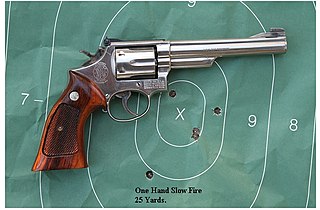
The Smith & Wesson Model 19 is a revolver produced by Smith & Wesson that was introduced in 1957 on its K-frame. The Model 19 is chambered for .357 Magnum. The K-frame is somewhat smaller and lighter than the original N-frame .357, usually known as the Smith & Wesson Model 27. A stainless steel variant of the Model 19, the Smith & Wesson Model 66, was introduced in 1971.

The Smith & Wesson Model 10, previously known as the Smith & Wesson .38 Hand Ejector Model of 1899, the Smith & Wesson Military & Police or the Smith & Wesson Victory Model, is a K-frame revolver of worldwide popularity. In production since 1899, the Model 10 is a six-shot, .38 Special, double-action revolver with fixed sights. Over its long production run it has been available with barrel lengths of 2 in (51 mm), 3 in (76 mm), 4 in (100 mm), 5 in (130 mm), and 6 in (150 mm). Barrels of 2.5 inches (64 mm) are also known to have been made for special contracts. Some 6,000,000 of the type have been produced over the years, making it the most-produced handgun of the 20th century.

The Smith & Wesson Model 586, is a six- or seven-shot double-action revolver chambered for the .357 Magnum cartridge; it will also chamber and fire .38 Special cartridges. The Model 586 has a carbon steel construction and is available in a blued or nickel finish; it is essentially the same firearm as the Model 686, which has stainless steel construction. It is also known as the Distinguished Combat Magnum.

The Smith & Wesson Model 686 is a six- or seven-shot double-action revolver manufactured by Smith & Wesson and chambered for the .357 Magnum cartridge; it will also chamber and fire .38 Special cartridges. Smith & Wesson introduced the Model 686 in 1981. It is the stainless steel version of the Model 586, which featured a blued steel finish. They are available ported and unported with a choice of 6- or 7-round cylinders.

The Smith & Wesson Model 15, initially the Smith & Wesson K-38 Combat Masterpiece, is a six-shot double-action revolver with adjustable open sights produced by Smith & Wesson on the medium-size "K" frame. It is chambered for the .38 Special cartridge and is fitted with a 4-inch (100 mm) barrel, though additional barrel options have been offered at various times during its production. It is essentially a shorter barrel version of the Smith & Wesson Model 14 and an adjustable-sight version of the seminal Smith & Wesson Model 10 with target shooting features.
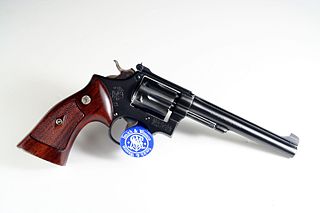
The Smith & Wesson K-22 Target Masterpiece Revolver is a six-shot, double-action revolver with adjustable open sights, built on the medium-size "K" frame. When introduced, it was intended for bullseye target shooting competition of the type then most common on the United States, which is today called NRA Precision Pistol, specifically in the "smallbore" or "22" category. It is chambered for the .22 Long Rifle cartridge. It is one of three similar models that Smith & Wesson offered, the other two being intended for the "centerfire" category, the K-32 Target Masterpiece chambered for the .32 S&W Long cartridge and the K-38 Target Masterpiece chambered for the .38 Special cartridge. Most K-22 revolvers were fitted with a 6 in (150 mm) or 8+3⁄8 in (210 mm) barrel, but other lengths have been produced. First produced in 1947 and originally known as the K-22 Target Masterpiece, it was numbered the Model 17 in 1957 when all Smith & Wesson guns were given numerical model numbers. It is built on the same frame as the seminal Smith & Wesson Model 10 revolver.

The GP100 is a family/line of double action five-, six-, seven-, or ten-shot revolvers made by Sturm, Ruger & Co., manufactured in the United States. Since its introduction, it has been produced with a number of variations including various barrel lengths and profiles, fixed or adjustable sights, and in blued carbon steel or stainless steel.
The Smith & Wesson Model 3 is a single-action, cartridge-firing, top-break revolver produced by Smith & Wesson (S&W) from around 1870 to 1915, and was recently again offered as a reproduction by Smith & Wesson and Uberti.

A snubnosed revolver is a small, medium, or large frame revolver with a short barrel, generally less than 3 inches in length. Smaller such revolvers are often made with "bobbed" or "shrouded" hammers and there are also "hammerless" models ; the point is to allow the gun to be drawn with little risk of it snagging on clothing. Since the external movement of the mechanism is minimal or nil, shrouded and hammerless models may be fired from within clothing. The design of these revolvers compromises range and accuracy at a distance in favor of maneuverability and ease of carry and concealment.

The Smith & Wesson Model 36 is a revolver chambered for .38 Special. It is one of several models of J-frame revolvers. It was introduced in 1950, and is still in production in the classic blued Model 36 and the stainless steel Model 60.

The Smith & Wesson Model 57 is an 'N' frame (large), double-action revolver with a six round cylinder, chambered for the .41 Magnum cartridge, and designed and manufactured by the Smith & Wesson firearms company. The gun was designed as a weapon for law enforcement agencies. However, due to size and recoil it found more favor with civilian target shooters and hunters.

The Colt Official Police is a medium frame, double-action revolver with a six-round cylinder, primarily chambered for the .38 Special cartridge, and manufactured by the Colt's Manufacturing Company. Released in 1908 as the Colt Army Special, the revolver was renamed the "Colt's Official Police" in 1927 in order to better market to law enforcement agencies. It became one of the bestselling police firearms of all time, eventually coming to exemplify typical law enforcement officer weaponry in the 1950s. The Official Police was also used by various U.S. and allied military forces during World War II.
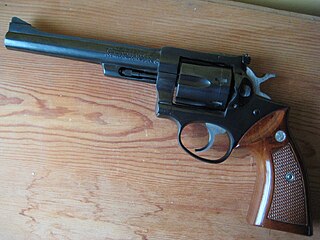
The Ruger Security-Six and its variants, the Service-Six and Speed-Six are a product line of double-action revolvers introduced in 1972 and manufactured until 1988 by Sturm, Ruger & Co. These revolvers were marketed to law enforcement duty issue, military, and civilian self-defense markets.

Smith & Wesson .38/44 identifies a series of 6-round cylinder, double-action, Smith & Wesson N-frame revolvers chambered for the .38 Special cartridge loaded to higher pressures than were considered appropriate for earlier revolvers chambered for that cartridge. High-pressure .38/44 loadings of the .38 Special cartridge represented a transition between conventional .38 Special ammunition and the new more powerful .357 Magnum ammo. Revolvers were manufactured from 1930 to 1941, and after World War II from 1946 to 1966 until competitively priced .357 Magnum revolvers became widely available.
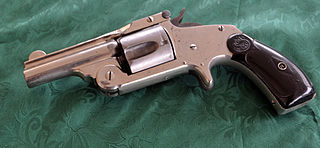
The Smith & Wesson Model 2, also referred to as the Smith & Wesson .38 Single Action, was a .38 caliber revolver produced in both single and double action by Smith & Wesson. The manufacturer's first of that caliber, its 5-shot cyclinder was chambered in .38 S&W. The single-action was produced in three varieties from 1876 through 1911, with total production exceeding 223,000 units; the double-action in three variants from 1880 to 1913, with total sales somewhat under one-million guns.
